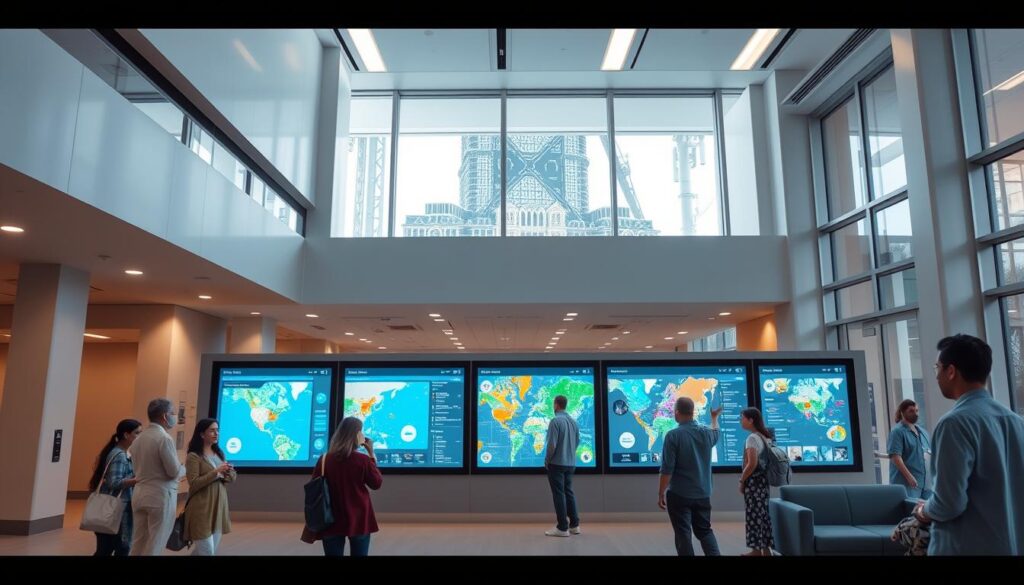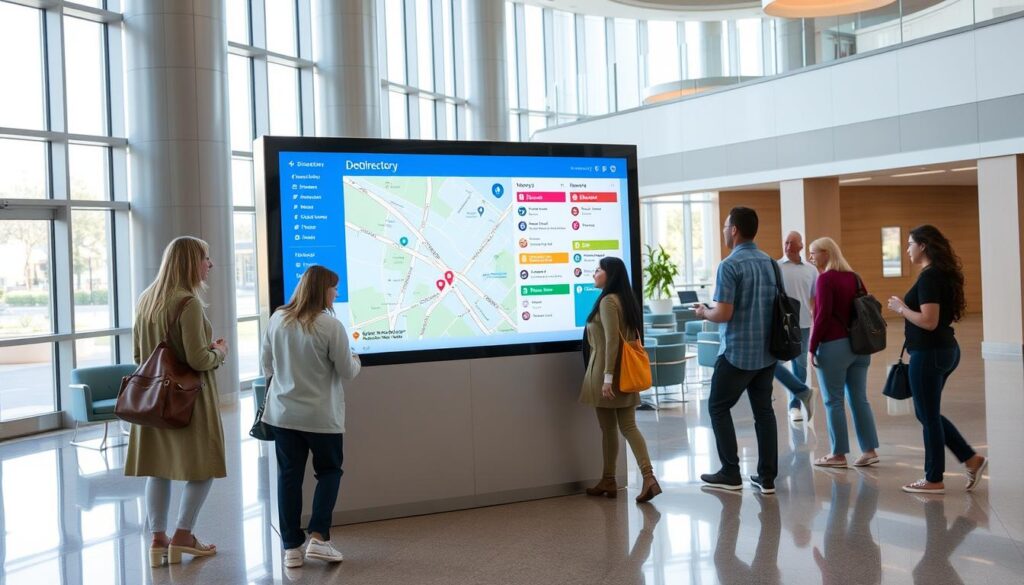Interactive hospital directories are changing how we experience healthcare. They use new tech like Bluetooth Low Energy (BLE), GPS, and Wi-Fi. This makes it easy for patients to find their way around the hospital.
These directories give updates in real time. They work with existing systems and can be accessed with a QR code. This means no need for extra hardware and patients can manage their visit better.
This change fits with a bigger trend in healthcare. During the COVID-19 pandemic, virtual care has grown a lot. Telemedicine use has gone up by 338% compared to before the pandemic.
People like virtual care because it’s easy and fast. It’s great for those who can’t get to the hospital easily. It’s also good for those living in adult family homes.

Key Takeaways
- Interactive hospital directories use new tech for easy navigation and updates.
- Virtual care, like telemedicine, has seen a big rise in use, thanks to its convenience.
- Working with existing systems can make hospital wayfinding better and improve patient experience.
- Digital solutions that are easy to use are key for meeting the needs of different patients.
- Personalized care and working together with patients are important for good health outcomes.
Understanding the Evolution of Hospital Navigation Systems
Hospital navigation systems have changed a lot. They moved from old static signs to new digital wayfinding solutions. These new systems use AI and computer vision to make hospitals safer and care better. They also change how people experience healthcare.
Traditional vs. Digital Wayfinding Solutions
Old hospital navigation was a maze of signs that could confuse people. Now, digital wayfinding solutions offer easy-to-use interfaces. They guide people through hospitals smoothly. These systems update in real-time and work well with hospital systems, changing how we move around hospitals.
The Impact of Technology on Patient Navigation
Technology has greatly improved hospital navigation. Digital systems cut down wait times and make it easier to get care. They give clear directions and updates, helping patients feel more confident and less stressed in hospitals.
Current Challenges in Hospital Navigation
Even with big steps forward, there are challenges left. Making sure these systems work with hospital tech and are accessible to everyone is key. Solving these problems will help make digital wayfinding even better for patients.
“Implementing interactive kiosks or mobile apps in hospitals can significantly ease anxiety in navigating large hospital complexes.”
Digital Innovation in Healthcare Wayfinding
The healthcare industry has seen big changes in how people find their way around hospitals. Digital innovation has made navigating hospitals easier and more efficient. This includes smart device integration, real-time updates, and features for everyone.
Smart Device Integration Features
Smart devices have changed the game in healthcare wayfinding. Now, patients and visitors can use their phones and tablets to find their way. They get directions, maps, and can find amenities easily.
Real-Time Updates and Information Management
Old signs and static info are a thing of the past. Digital wayfinding gives updates on hospital operations in real-time. This means patients and visitors always have the latest info to make good choices.
Accessibility Features for Diverse User Groups
Digital wayfinding focuses on making things accessible for everyone. It includes features like text-to-speech, braille kiosks, and voice navigation. This helps people with different challenges to move around hospitals easily.
Digital wayfinding has made hospitals better for patients, more efficient, and accessible. As technology gets better, hospital navigation will keep improving. This will make the healthcare experience even better for everyone.

“Digital wayfinding systems have revolutionized the way patients and visitors navigate hospital campuses, making it more inclusive and efficient.”
Benefits of Interactive Directory Implementation
Interactive directories in healthcare facilities bring many benefits. They make patient experience better and help with operational efficiency. These solutions work well with virtual care platforms, making the patient journey better.
Interactive directories help patients feel more at ease. They provide clear directions and updates in real-time. This makes it easier for patients to find what they need, reducing stress and confusion.
- Digital signage reduces confusion and saves time for patients and visitors navigating hospitals.
- Interactive directory kiosks help customers simplify navigation within a hospital with touch screens and search functions.
- Mobile integration with digital directory kiosks ensures seamless access to content for patients and visitors.
Interactive directories do more than just improve patient experience. They also make healthcare more efficient. They help staff save time and make better use of resources. This lets patients take a more active role in their care, fitting with the trend of patient empowerment.
| Metric | Impact |
|---|---|
| User Engagement | 30% increase in buildings with interactive directories (University of Illinois study) |
| Navigation Time | 25% reduction in visitor navigation time (Commercial real estate firm case study) |
| Brand Awareness | 47.7% increase in digital building directories (Relevant to hospitals as retail environments) |
Healthcare providers can benefit a lot by adding interactive directories to their digital plans. They get better patient experience, more healthcare efficiency, and more digital transformation in their facilities.

Measuring Success and ROI
It’s key to check how well interactive hospital directories work and if they’re worth the cost. By looking at important metrics, hospitals can see the real benefits. This helps them decide where to spend more money.
Things like happy patients, shorter wait times, and smoother operations are key signs of success. When figuring out ROI, think about things like needing fewer staff for directions. Also, fewer missed appointments and better flow in the hospital are important. Making sure everyone can use the system, no matter their language, is also a big plus.
As healthcare gets more digital, checking ROI will become even more important. By linking these checks to bigger goals, hospitals can show how these tools really help. This approach not only proves the value but also helps make things better for patients.
FAQ
What are interactive hospital directories?
Interactive hospital directories are digital tools that help guide patients through their healthcare journey. They use technologies like Bluetooth Low Energy (BLE), GPS, and Wi-Fi. This makes navigation easy and provides real-time updates.
They work with existing systems and can be accessed through QR codes. This means no need for extra hardware.
How have hospital navigation systems evolved?
Hospital navigation systems have changed a lot. They used to be just static signs. Now, they use AI and computer vision for better patient safety and care.
Companies like LookDeep are leading the way. They help staff watch over more patients at once.
What are the benefits of digital innovation in healthcare wayfinding?
Digital innovation in healthcare wayfinding is a big step forward. It lets patients use their own devices for navigation. This makes it easy and convenient.
It also offers real-time updates on wait times and emergencies. Plus, it’s more accessible for everyone, including those with disabilities.
What are the advantages of implementing interactive hospital directories?
Interactive directories bring many benefits. They make patients happier and less stressed. They also make hospitals run more smoothly.
These systems work well with virtual care platforms. This improves the patient experience. It also helps healthcare providers by saving time and resources.
How can the success of interactive hospital directories be measured?
Success can be measured in several ways. Look at patient satisfaction, wait times, and how well the hospital runs. Also, consider the return on investment (ROI).
ROI can be based on things like saving on staff for directions and fewer missed appointments. It’s also about better patient flow and support for different languages.